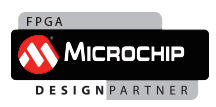Today DEC (Defense Engineering Corporation, Beavercreek, OH USA) and MLE (Missing Link Electronics, Inc., San Jose, CA USA) announced they have collaborated to develop a high performance, Multi-RAID SSD Streaming System to incorporate into high performance data recording systems for the US Defense Dept. The system will be provided by DEC.
Dan Whitehead adds: “DEC is a Government Contractor working with the US Defense Dept. When we needed to develop a fast, SSD multi-RAID NVMe streamer for one of our projects, we became aware of Missing Link Electronics by way of Xilinx’s Premier Partners Program. This project required advanced knowledge of both specialized hardware and communication protocols to meet our customers exacting requirements. MLE came in, evaluated our needs, and developed the technical design using their own NVMe IP and in-depth hardware and software expertise to provide, on time and on budget, a board level solution to integrate into our system design. MLE provided unique benefit by having great access to our supplier’s technology, advanced IP, and specialized, hands-on expertise. I recommend MLE to others needing advanced expertise in programmable hardware and software design. Working with them is a pleasure and produces excellent results.”
Andreas Schuler, MLE Product Engineering, commented: “When we were approached by DEC we were happy to see that our long-time affiliation with the Xilinx Premier Partners Program provided a challenging opportunity to work with a top-notch engineering team at DEC. We were successfully able to combine our NVMe Streamer technology with DEC’s expertise in providing system-level technology to the US Defense Department. This produced an excellent result in which both companies take pride.”
DEC specializes in advanced sensor and processing technologies for Intelligence, Surveillance, and Reconnaissance (ISR), Unmanned Systems, and Self-Protection applications for the defense industry.
MLE is an intellectual property (IP) and software and hardware design services company based in San Jose, CA. It is a proud member of the Xilinx Premier Partners Program. MLE utilizes an extensive catalog of in-house developed IP for network connectivity, storage protocols and I/O interfaces for programmable platforms in its work. It develops solutions for international commercial, automotive, and Defense and Aerospace customers.
 MLE has successfully tested NVMe Streamer a so-called Full Accelerator NVMe host subsystem for PCIe 4.0. Test setup was the Xilinx ZCU216 Development Kit featuring Zynq UltraScale+ RFSoC Gen3, and the new FPGA Drive FMC Gen4 from partner Opsero. The combined solution doubles bandwidth for modern PCIe Gen4 x4 M.2 NVMe SSD.
MLE has successfully tested NVMe Streamer a so-called Full Accelerator NVMe host subsystem for PCIe 4.0. Test setup was the Xilinx ZCU216 Development Kit featuring Zynq UltraScale+ RFSoC Gen3, and the new FPGA Drive FMC Gen4 from partner Opsero. The combined solution doubles bandwidth for modern PCIe Gen4 x4 M.2 NVMe SSD.
 At the
At the 

 MLE has joined the Microchip Ecosystem as a Premier Design Partner. "Our customers have asked us to extend MLE's design services to include MicroSemi's FPGA families. In particular for industrial applications MicroSemi's PolarFire seems to provide a great combination of longterm availability, cost-efficiency and high-speed I/Os needed for PCIe and/or 10 Gigabit Ethernet.", says Endric Schubert, CTO and Co-Founder.
MLE has joined the Microchip Ecosystem as a Premier Design Partner. "Our customers have asked us to extend MLE's design services to include MicroSemi's FPGA families. In particular for industrial applications MicroSemi's PolarFire seems to provide a great combination of longterm availability, cost-efficiency and high-speed I/Os needed for PCIe and/or 10 Gigabit Ethernet.", says Endric Schubert, CTO and Co-Founder.